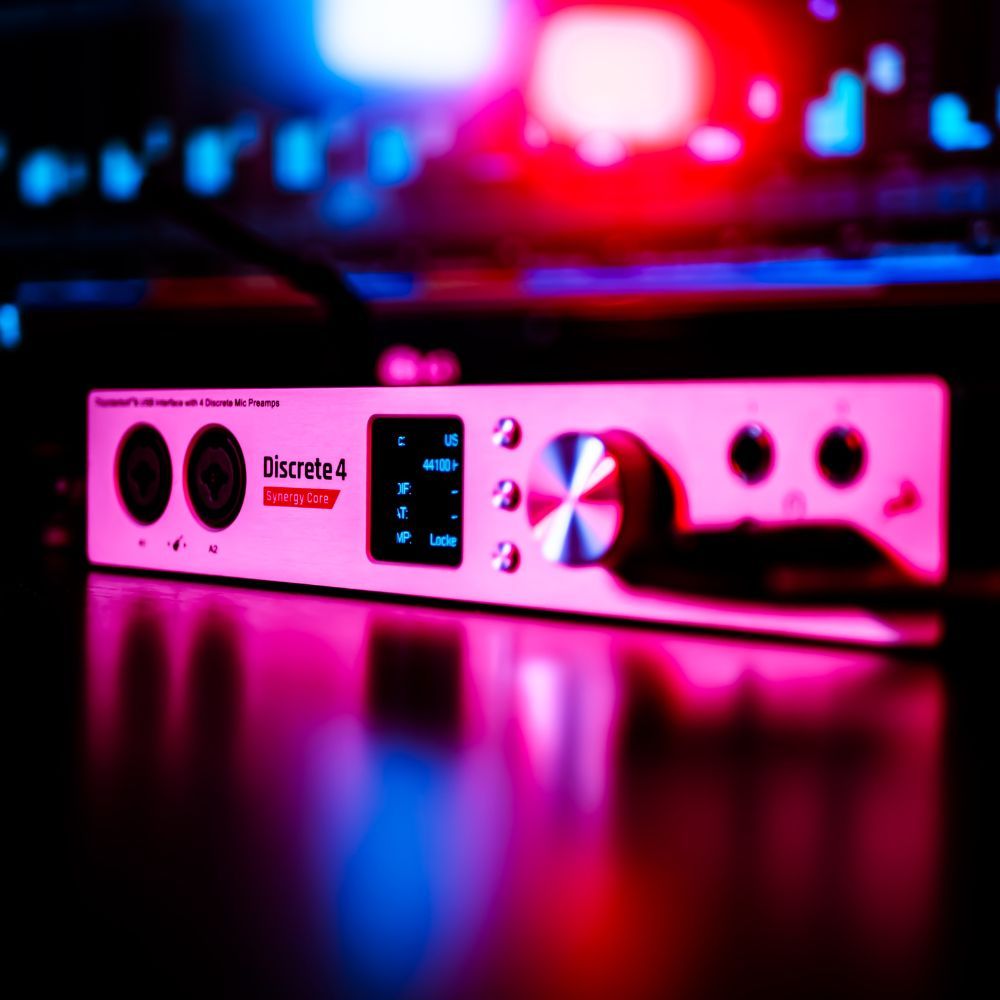From Instrument to Computer: The Best Guitar Interface
Learn the features to look for and how to choose the best guitar interface for your budget and situation, along with our Top 5 recommendations!

As a guitarist, you know that achieving the perfect sound is essential. Whether you're recording, practicing, or performing live, having the best guitar interface can make all the difference. A guitar audio interface is a device that connects your guitar to your computer or iOS device, allowing you to record, edit, and manipulate your guitar's audio signal in a digital audio workstation (DAW). These devices come in various shapes and sizes, with different inputs and outputs, audio quality, and compatibility options.
A high-quality guitar interface is crucial for capturing the true essence of your playing. It ensures that your recordings are clean, crisp, and free from unwanted noise or interference. Additionally, a good interface allows you to easily integrate with your recording software, providing seamless guitar recording sessions, and some even allow for mobile recording.
In this article, we'll explore the top 5 guitar audio interfaces on the market, discuss their features, pros, and cons, and provide helpful suggestions to help you choose the ideal device for your needs.
Overview of the Guitar Audio Interface
The history of modern guitar interfaces dates back to the early 2000s when digital recording began to gain momentum. Musicians who wanted to record their guitar performances faced a significant challenge of finding a reliable interface that could deliver high-quality sound to their computers. The first audio interfaces were bulky and expensive, limited in their functionalities and compatibility with different types of devices.
As technology progressed, guitar audio interfaces became more refined, offering improved sound quality and more features. Today, guitar audio interfaces come with a range of inputs and outputs, such as XLR combo MIDI, micro USB input types, and phantom power. They allow for direct monitoring and boast dynamic range, making recording guitar a breeze.
Some of the leading brands in the market include Native Instruments, IK Multimedia Axe, Positive Grid, Universal Audio Volt, and Best Guitar Audio Interface deals. They have revolutionized the industry by producing high-quality guitar audio interfaces that work seamlessly with both PCs and Macs.
The best guitar audio interfaces come with a mic preamp and are compatible with condenser mics, ensuring that the recorded sound is of superior quality. They also possess a headphone output for easy listening while recording, along with the capability to connect to all the inputs necessary for recording a guitar performance.
Some of the popular audio interfaces available in the market today are the Universal Audio Apollo Twin and the IK Multimedia iRig HD. The Universal Audio Apollo Twin is considered to be one of the best audio interfaces for guitar recording, thanks to its superior audio quality and extensive range of features. On the other hand, the IK Multimedia iRig HD is a favorite amongst beginner guitarists due to its ease of use and affordability.
In conclusion, the history of guitar interfaces has evolved over the last two decades, and today's best deals are offering a range of options to choose from. With most interfaces now available with digital recording capabilities, it is now possible to record high-quality guitar performances more efficiently, with better sound quality and greater ease of use.
Guitar Interface Considerations
Compatibility
Ensure that the interface is compatible with your computer or iOS device, as well as your preferred recording software (e.g., Ableton Live Lite, Pro Tools, etc.). Most interfaces support both Mac and PC connections.
Inputs and Outputs
Consider the number of instrument inputs, microphone inputs, line inputs, headphone outputs, and monitor speaker outputs you require. For most guitarists, a single Hi-Z instrument input and one or two XLR combo inputs will suffice.
Audio Quality
Choose an interface that provides excellent audio quality with a wide dynamic range and low noise floor. Look for devices with high-quality mic preamps, phantom power for condenser mics, and direct monitoring to avoid latency issues.
Price
Determine your budget and compare the features, pros, and cons of each interface within your price range. Keep in mind that today's best deals may not always provide the quality and functionality you need.
Top 5 Best Guitar Audio Interfaces
Universal Audio Apollo Twin
The Apollo Twin is a high-quality desktop interface that offers a combination of features, performance, and ease of use. With its dual headphone outputs, two monitor speaker outputs, and Universal Audio's renowned mic preamps, this device delivers exceptional audio quality and versatility.
Pros:
- High-quality audio
- Dual headphone outputs
- Wide compatibility
Cons:
- Expensive
IK Multimedia Axe I/O Solo
The Axe I/O Solo is a compact and affordable option designed specifically for guitarists. It features a Hi-Z instrument input, active pickups compatibility, and three preset preamp emulations for a wide range of tonal options.
Pros:
- Guitar-focused features
- Affordable
- Compact design
Cons:
- Limited inputs and outputs
Native Instruments Komplete Audio 6
This interface provides a solid balance of affordability and performance, with two XLR combo inputs, a Hi-Z instrument input, and four line inputs. Its compatibility with both Mac and PC connections makes it a popular choice among musicians.
Pros:
- Good balance of price and performance
- Four line inputs
Cons:
- No built-in guitar amp modeling
Audient iD4 MKII USB-C Audio Interface
The iD4 MKII is a great choice for both experienced and novice guitarists. It has two mic preamps, phantom power capability, a Hi-Z input, and various connection options. Additionally, it comes with a range of plug-ins to enhance your sound.
Pros:
- Two mic preamps, Hi-Z input, Phantom power
Cons:
- No dedicated headphone outputs
Universal Audio Volt 276
The Volt 276 is a versatile, budget-friendly option that delivers impressive audio quality thanks to its dual mic preamps and Hi-Z instrument input. With its simple setup and intuitive design, this interface is perfect for beginners and experienced musicians alike.
Pros:
- Budget-friendly, Easy to use, Solid audio quality
Cons:
- Lacks some advanced features
How to Set Up a Guitar Interface
- Connect your guitar to the Hi-Z instrument input using a standard 1/4" cable.
- Connect the interface to your computer or iOS device using the appropriate cable (USB, Micro USB, or Thunderbolt).
- Install any necessary drivers or software, as specified by the manufacturer.
- Open your DAW and select the interface as your input and output device.
- Adjust input levels, monitoring settings, and other preferences as needed.
Tips for Recording Guitar
- Use high-quality cables to minimize noise and interference.
- Experiment with different microphone placements and techniques for capturing the best sound.
- Utilize virtual guitar amps and effects within your DAW to enhance your tone.
- Record multiple takes and comp them together for the best performance.
Digital Audio Workstation Integration
Most guitar interfaces integrate seamlessly with popular DAWs such as Pro Tools, Ableton Live Lite, Logic Pro X, and others. This allows you to record, edit, and mix your guitar tracks with ease, using virtual instruments, effects, and other tools to create professional-sounding recordings.
Guitar Audio Interface FAQs
1. Can I use a guitar interface with acoustic guitars?
Yes, most interfaces can be used with both electric and acoustic guitars, provided your acoustic guitar has a pickup installed.
2. What is the difference between Hi-Z input and regular instrument input?
A Hi-Z input is specifically designed for high impedance instruments like guitars and basses, ensuring a clean and accurate signal.
3. Do I need an external power source for my guitar interface?
Some interfaces require an external power source, while others are bus-powered through their USB or Thunderbolt connection.
4. Can I connect my guitar amp directly to the interface?
Yes, many interfaces have line inputs that allow you to connect your guitar amp's output for direct recording.
5. Can I use my guitar interface for live performances?
Yes, some interfaces offer live performance features such as real-time monitoring, on-board effects processing, and MIDI control capabilities.
6. Are there any guitar interfaces compatible with Android devices?
While most other interfaces are designed for iOS devices or computers, there are some options available for Android users, such as the IK Multimedia iRig HD-A.
7. Can I connect multiple instruments simultaneously to my interface?
Some interfaces offer multiple instrument inputs, allowing you to connect multiple guitars or other instruments for simultaneous recording.
8. What is the benefit of having a combo input on my guitar interface?
A combo input allows you to connect both XLR and 1/4" cables, providing flexibility for connecting microphones, guitars, and other instruments.
9. Do I need a separate headphone amp for my guitar interface?
Most desktop interfaces include at least one headphone output, eliminating the need for a separate headphone amp.
10. Is latency an issue when using a guitar interface?
Modern interfaces and DAWs typically offer low-latency monitoring options, ensuring that you can play and record without noticeable delays.
Conclusion: The Best Guitar Audio Interface
To sum up, guitar audio interfaces are essential tools for any musician who wants to record high-quality audio on their computer.
- A guitar audio interface is a device that allows you to connect your guitar or other instrument to your computer, providing high-quality audio inputs and outputs.
- There are numerous guitar audio interfaces available in the market, ranging from basic models that provide simple inputs and outputs, to more advanced models with phantom power, XLR combo MIDI inputs, and headphone outputs.
- Some of the best guitar audio interfaces on the market today include the Universal Audio Apollo, the IK Multimedia Axe, and the Positive Grid. These devices offer a wide range of inputs and outputs, Mac and PC connection, as well as direct monitoring and dynamic range that can accommodate any recording need.
- With today's best deals, you can get the best guitar audio interface that suits your needs and budget. The Universal Audio Apollo, for instance, is packed with high-quality preamps and features that guarantee pristine sound quality, while the IK Multimedia offers top-notch condenser mics and XLR combo MIDI inputs. Finally, the Positive Grid comes with a built-in amp modeler and headphone output that makes it an ideal choice for guitar players.
Choosing the best guitar audio interface for your needs is crucial to achieving the highest audio quality and seamless integration with your recording software. By considering factors such as compatibility, inputs and outputs, audio quality, and price, you can find the perfect device to elevate your guitar playing and recording experience.
Once again, here are our favorites:
Best Overall: Universal Audio Apollo Twin
Best for Versatility: IK Multimedia Axe I/O Solo
Best Value for Money: Native Instruments Komplete Audio 6
Best Budget Option: Audient iD4 MKII USB-C
Best for Beginners: Universal Audio Volt 276
Thanks for checking us out, and keep rockin’!
*FYI, when you make a qualifying purchase through one of our links, we might receive a small commission from Amazon or other retailers, at no additional cost to you, which helps us to fund this site. It's a way to find what you're looking for while supporting us in the process!





